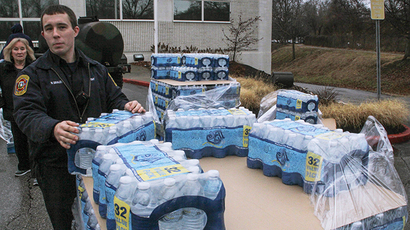West Virginia chemical tests improve but water still undrinkable

Over 300,000 West Virginia residents have spent a fifth day without tap water. Despite the governor of the state saying that a cleanup is underway and the situation is “encouraging”, it’s still uncertain when people will be able to open their taps.
The accident took place on Thursday at a facility in Charleston, the state capital, run by Freedom Industries. 4-Methylcyclohexane Methanol, a hazardous chemical used in the process of coal washing, leaked out of a 40,000-gallon (151,000 liters) tank along the Elk River. A state of emergency was immediately announced in nine of West Virginia’s counties.
"Our team has been diligently testing samples from throughout the affected area, and the numbers look good,” said Earl Ray Tomblin, the governor of West Virginia.
However, neither governor nor state officials specified when exactly the drinking water ban might be lifted and when people will be able to use tap water again. They [governor and officials] only spoke about the creation of a website where residents can check the progress in water samples and when the restriction is lifted in their area.
Many restaurants, hotels and shops started reopening in different parts of West Virginia. The restaurant owners have to buy scores of bottles of water in order to reopen their businesses.
A dozen restaurants were allowed to reopen in Charleston on Sunday afternoon by the Kanawha-Charleston health department as they assured the officials they have a source of drinkable water, reports Reuters.
Meanwhile, all schools and several businesses in four West Virginia counties remain closed for an indefinite term.
West Virginia officials wouldn’t comment on the economic cost of the spill.
A team dispatched by the US Chemical Safety Board is expected to arrive in West Virginia on Monday to investigate what led to a leak of such proportions.
Numerous water tests have already been made in the region. Testing near the water treatment facility has consistently been below one part per million for 24 hours, a key requirement officials need before they can lift the ban, said Maj. Gen. James Hoyer, of the West Virginia National Guard. Some other tests also showed the absence of the chemical in water coming in and out of the factory.

However, local residents complain about the problems connected with health and personal hygiene since the leak happened. They were even told not to wash their clothes in affected water, as the compound can cause symptoms ranging from skin irritation to vomiting.
“Some 1,045 people have called the West Virginia Poison Center since the spill to say they or someone in their household had been exposed,” said Karen Bowling, Cabinet Secretary of the West Virginia Department of Health and Human Resources, reports Reuters.
Over 70 people had visited emergency rooms with symptoms of nausea, vomiting, dizziness, diarrhea, rashes and reddened skin, she added.
According to Jeff McIntyre, president of West Virginia Water they “will lift the water bans by zone,” but again he didn't say how soon it would be.
Local lawmakers are now trying to find out how the leak happened. But the problem isn’t new. The chemicals in these tanks are not considered hazardous enough to require environmental permits.
“Freedom Industries wasn't under state oversight at all; we don't have the regulatory authority to inspect those tanks” said Michael Dorsey, chief of the state Department of Environmental Protection's Homeland Security and Emergency Response office.
However, there's already talk about demanding the regulatory authority to inspect tanks, commented Randy Huffman, the Department of Environmental Protection’s secretary.
There were also signs that Freedom Industries have not responded appropriately to the officials’ announcement. The state law requires immediate reporting on the situation. But state environmental workers were on the spill site at 11:15 am on Thursday because of a call from the water company - not Freedom Industries, said Huffman.
Freedom Industries removed the remaining chemical from the site, said company president, Gary Southern, during a brief news conference, adding the company “has mitigated the risk.”

Meanwhile, the accident is not considered as “a coal company incident,” as this was “a chemical company incident,” stresses Tomblin.
“It just so happens that the chemical has some applications to the coal industry, just that fact alone shouldn't cause people to point fingers at the coal industry," said Jason Bostic, vice president of the West Virginia Coal Association.
West Virginia, the second-largest coal producing state after Wyoming and location of many chemical plants, has seen many accidents that killed dozens of workers in both industries and harmed the environment.














